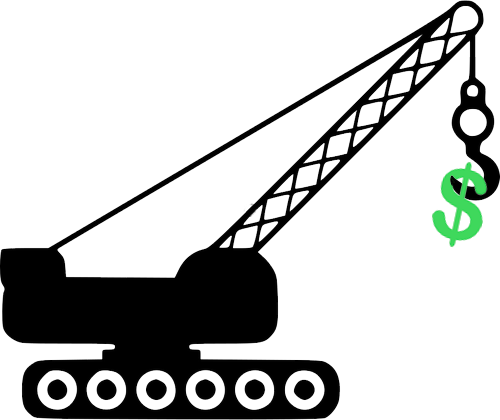Suppose you wanted to build a tower. Wouldn’t you first sit down and check if you have enough money to complete it? I call that “Counting the Cost”…

“For if you lay the foundation and are not able to finish it, everyone who sees it will ridicule you saying, this person began to build and wasn’t able to finish.”
These wise words written 2000 years ago are still true today. And these foundational truths has guided me well for many years, from running multiple businesses to navigating life.
In this Blog Post, I’m focusing on how to determine what it will cost to clean a building before you set your bid price. You MUST “Count the Cost” first!
Based on my three decades in the Janitorial Industry, here’s my Top 10 list of considerations required to calculate a profitable Janitorial Bid!
- GENERAL BUILDING TYPE: Different building types have different cleaning times/production rates. A 3,000 sq’ fully carpeted Library may only take 2 hours to clean, while a 3,000 sq’ Medical Clinic with 1500 sq’ of waxed VCT floors may take 4 hrs.
- CLEANING FREQUENCY AND LEVEL OF DIFFICULTY: Cleaning difficulty level is gauged not just by the size of a building, but rather by looking at the number of employees in the building (Building Density), plus the number of customers or patients or clients – the “Traffic” – that frequents this building on a daily basis. Higher building density/traffic results in longer cleaning times, which equates to a slower cleaning production rate for you and your cleaning staff. Basically, the more people in and out each day equals more trash, spills, messes, etc., which means it takes you longer to clean.
- CLEANABLE SQUARE FOOTAGE AND FLOORING TYPE: Whether you count ceiling tiles, get the number from your potential customer, or look online at the County Property Appraiser, make sute that you get the actual Cleanable Square Footage. Did you know that carpeted floors clean 15-20% faster than hard floors? And that waxed, vinyl tile floors with a shine can take 10% longer to sweep and mop than other hard floors like ceramic tile?
- DETERMINE PRODUCTION RATE: A facility’s Production Rate refers to how many square feet of a building can be cleaned by one person, in one hour, performing a set of standard cleaning tasks. Of course, you will have a much slower production rate when doing residential and construction cleaning.
- TOTAL DAILY CLEANING/LABOR HOURS: Once you have your Production Rate, this rate is then used to compute how many hours are required to clean a building per visit (i.e., the Daily Cleaning Hours). And once the Daily Cleaning Hours have been workloaded – that is, labor and wages have been distributed across these hours – then the bid’s Labor Costs can be computed by the system.
- LABOR COSTS: Once the Daily Cleaning Hours have been workloaded – that is, labor and wages have been distributed across these hours – then the bid’s Labor Costs can be totaled.
- ADDITIONAL PAYROLL COSTS: These costs typically include applicable Federal, State dan Local Taxes, as well as Work Comp, etc. There are government websites that can give you your state rates to go by. Your Accountant can help you. Also, there are many payroll software programs as well as many Employee Payroll Companies and Employee Leasing Companies that will give you an exact percentage.
- CHEMICAL /SUPPLY COSTS: These can run 3-10% of your monthly costs and expenses. These costs typically include floor cleaner, glass cleaner, all-purpose cleaner, disinfectant cleaner, bowl cleaner, stainless steel polish, etc. Buy chemicals in dilutable, concentrate form to keep costs down. Chemical mixing stations are great also. Products like bowl cleaner and stainless steel cleaner are usually sold “ready to use” (RTU), and cost a bit more, so shop around for reasonable pricing. Equipment like vacuums, buckets, floor buffers, etc. are an upfront cost that can be depreciated over time (talk to your Accountant).
Chemicals like floor stripper, floor finish and carpet cleaner are an expense if you provide your customer with extra Specialty Work, but is included when and if you add these services in your bid. - OTHER MISCELLANEOUS COSTS / EXPENSES / OVERHEAD: These typically include things like.. higher level managers over multiple buildings doing inspections, training, cell phone costs, fuel, etc. When you’re just starting out with only a few buildings to clean, these costs are minimal and can be hard to define, but figure in at least 2-3% to be on the safe side, even if you are the only employee and do all the work.
- TOTAL JANITORIAL COSTS / EXPENSES: Congratulations, now that you’ve calculated all of these costs and expenses you’re ready to “SET YOUR PRICE” (via Profit Margin or Cost Markup)!
Keep in mind: When you get requests for a Janitorial Proposal, that’s the time to create a winning bid! If you’re content with the way you’ve been calculating your Total Janitorial Costs/Expenses,” that’s great. But if you’re looking for a proven competitive edge – my automated best practices – I encourage you to try a free 30 day trial of CleanlyRun Janitorial Bidware.
Check us out at CleanlyRun.com… Let’s grow your business!


